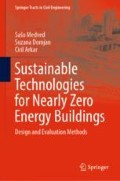Abstract
In addition to the large scale power plants presented in Chap. 2, there are several technologies for dispersed or in situ generation of electricity. In general these technologies use local renewable energy sources in the form of solar and wind energy or biomass. Small scale hydropower plants are a highly efficient technology with high durability and low maintenance costs; nevertheless, they will not be presented here because these devices are only useful for near-by electricity generation. Fossil or gaseous biomass fuels can be used for electricity generation on-site with the combined generation of heat and electricity. As an emerging technology, hydrogen driven fuel cells will also be presented in this chapter.
Access this chapter
Tax calculation will be finalised at checkout
Purchases are for personal use only
Notes
- 1.
Directive 2001/77/EC of the European Parliament and of the Council of 27 September 2001 on the promotion of electricity produced from renewable energy sources in the internal electricity market (Official Journal of the European Union, L 283/33).
- 2.
Directive 2009/28/EC of the European Parliament and of the Council of 23 April 2009 on the promotion of the use of energy from renewable sources and amending and subsequently repealing Directives 2001/77/EC and 2003/30/EC (Official Journal of the European Union, L 140/16).
- 3.
Proposal for a Directive of the European Parliament and of the Council on the promotion of the use of energy from renewable sources (recast); COM/2016/0767 final/2-2016/0382 (COD).
- 4.
Uredba o samooskrbi z električno energijo iz obnovljivih virov energije (Decree on self-supply of electricity from the renewable energy sources) (Uradni list RS, št. 97/15 in 32/18).
- 5.
- 6.
- 7.
energynumbers.info.
- 8.
- 9.
- 10.
ens.dk.
- 11.
Producers’ technical information.
References
ENVIMPACT, Increasing the impact of Central-Eastern European environment research results through more effective dissemination and exploitation, Grant agreement n° 265275
Twidell J, Weir T (1996) Renewable Energy Resources. TNP Cambridge
Author information
Authors and Affiliations
Corresponding author
Rights and permissions
Copyright information
© 2019 Springer Nature Switzerland AG
About this chapter
Cite this chapter
Medved, S., Domjan, S., Arkar, C. (2019). Best Available Technologies (BAT) for On-Site Electricity Generation for nZEB. In: Sustainable Technologies for Nearly Zero Energy Buildings. Springer Tracts in Civil Engineering . Springer, Cham. https://doi.org/10.1007/978-3-030-02822-0_7
Download citation
DOI: https://doi.org/10.1007/978-3-030-02822-0_7
Published:
Publisher Name: Springer, Cham
Print ISBN: 978-3-030-02821-3
Online ISBN: 978-3-030-02822-0
eBook Packages: EngineeringEngineering (R0)

